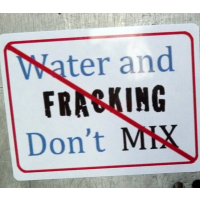“Discussion Draft” of First-Ever Fracking Regulations Raises a Howl from Environmentalists
 (photo: ecowatch.org)
(photo: ecowatch.org)
After 50 years of drilling for oil and gas using the controversial practice of hydraulic fracturing, or fracking, the state has finally proposed regulations for the previously unmonitored process―and some environmental groups find them wholly lacking.
The Center for Biological Diversity called “discussion draft” regulations by the California Department of Conservation’s Division of Oil, Gas, and Geothermal Resources fatally flawed because they “would keep California's fracking shrouded in secrecy and do little to contain the many threats posed by fracking.” Kassy Siegel, director of the center’s Climate Law Institute, said the proposal was “worse than nothing” and is going to have to be “completely rewritten if the goal is to provide real protection for our air, water and communities.”
Fracking entails injecting millions of gallons of pressurized water, chemicals (some toxic), sand and other substances into a well to crack open the rocks and allow easier access to oil and natural gas. Critics say it has been linked to groundwater contamination, air pollution, releases of methane gas, micro-earthquakes and sink holes.
While it has long been used to tap energy supplies unreachable using conventional methods, it has received heightened interest of late from oil and gas companies eager to explore difficult-to-reach supplies embedded in shale. California has the nation’s largest known shale deposits, stretching along a huge swath of the Central Valley up to Monterey County.
The state is poised for a possible oil boom, with Monterey Shale thought by some to hold up to 15.5 billion barrels of oil. Last week, the federal Bureau of Land Management auctioned off around 18,000 acres of Monterey Shale oil leases.
But with fracking coming under increasing criticism across the country, and state lawmakers failing to pass proposed legislation last session that would have imposed minimal transparency about where fracking was occurring and what chemicals were being injected near groundwater, pressure has mounted for some meaningful response from the state.
The Center for Biological Diversity said the proposed regulations fail in key ways. Directly affected property owners would only get three days notice from the state that fracking will occur, and the notification would not include adjacent property owners whose water supply and air were potentially at risk.
Energy companies would have to inform the state what chemicals were being injected into the ground, but a giant loophole would allow them to keep private any chemicals they deemed “trade secrets.” Those chemicals they choose to publicize, and other related information, would be conveyed through the online database Frac Focus, considered by many to be difficult to navigate and industry friendly.
There is no process explicitly laid out for appeals by property owners who oppose the fracking, and well operators wouldn’t be required to collect pollution data that could be used to gauge environmental effects.
The oil industry was pleased with the proposal. “We certainly appreciate the effort that the Department of Conservation is making on these,” Tupper Hull, a spokesman for the Western States Petroleum Association, told the San Jose Mercury News. “We are encouraged that they continue to recognize the important role that hydraulic fracturing can play in the state's economy.”
–Ken Broder
To Learn More:
California Releases First-Ever Fracking Regulations (by Paul Rogers, San Jose Mercury News)
Five Fatal Flaws in California's New Fracking Regulations (Center for Biological Diversity)
California Oil Regulators Release Draft of Fracking Rules (by Michael J. Mishak, Los Angeles Times)
California Releases Draft Fracking Regulations (by Jason Dearen, Associated Press)
State Moves Slowly on Oil Extraction Rules Favored by the Feds (by Ken Broder, AllGov California)
- Top Stories
- Controversies
- Where is the Money Going?
- California and the Nation
- Appointments and Resignations
- Unusual News
- Latest News
- California Forbids U.S. Immigration Agents from Pretending to be Police
- California Lawmakers Urged to Strip “Self-Dealing” Tax Board of Its Duties
- Big Oil’s Grip on California
- Santa Cruz Police See Homeland Security Betrayal in Use of Gang Roundup as Cover for Immigration Raid
- Oil Companies Face Deadline to Stop Polluting California Groundwater





